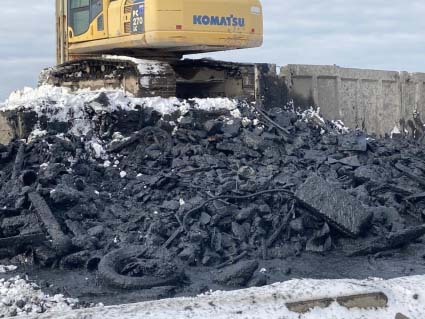INTRODUCTION
Dredged material is processed according to the Level 1 Archaeological Monitoring protocol outlined in the draft Cultural Resource Monitoring Plan (revised September 2020). This protocol calls for dredged soft sediments to be placed directly into barges, floated to the processing facility, and screened over bars on a vibrating platform. Items removed during the vibratory screening process are then sorted by trained personnel as per the Cultural Resource Monitoring Plan. Items of potential interest (possible artifacts or objects of local interests) are placed in a separate stockpile and photographed daily for archaeologists to review. These items are then placed in a holding area for archaeologists to inspect. To date, the vast majority of the recovered items consisted of modern debris and timbers.
RESULTS
An archaeologist conducted a scheduled site visit on 12/18/20 to review the recovered items in person with the assistance of a dredge material processing facility machine and operator to sort through stockpiled items. Photographs were taken of stockpiled items.
The recovered items were spread by machine on a flat hard surface to allow for an archaeologist to clearly review them (Photographs 1 through 6). Any item of potential interest was separated, rinsed and assessed. Approximately 50% of the items reviewed consisted of irregular shaped rocks averaging 10 inches in diameter (Photograph 1). The majority of the other items reviewed consisted of modern debris, including wheels (Photograph 2), large concrete blocks (Photograph 3) and wood and timbers including possible notched bulk-head timbers (Photographs 4 & 5). One item was recommended for retention; an approximately 3’ long piece of wood that is curved and notched (Photograph 6). Additional research may be able to determine its use or what implement it was part of. The wooden object was set aside for additional cleaning.






ITEMS SEPARATED FOR FURTHER REVIEW
The archaeologist preliminarily identified one piece of shaped wood from the screening of Level 1 dredged debris to be retained for further analysis and possible documentation.
CONCLUSIONS AND RECOMMENDATIONS
The archeologist concludes that one item recovered during the sediment screening retains possible historic/archaeological significance. Therefore, the archeologist recommends that this single piece of wood be retained for further analysis and possible documentation.
Figure 1 indicates the approximate area that was dredged. Per the draft Cultural Resource Monitoring Plan, the archeologist further recommends that all the non-historic/archaeologically significant debris that has been reviewed by the archaeologist as of 12/18/2020 may be disposed of.

Dredging was not conducted on December 17th or 18th, 2020.
